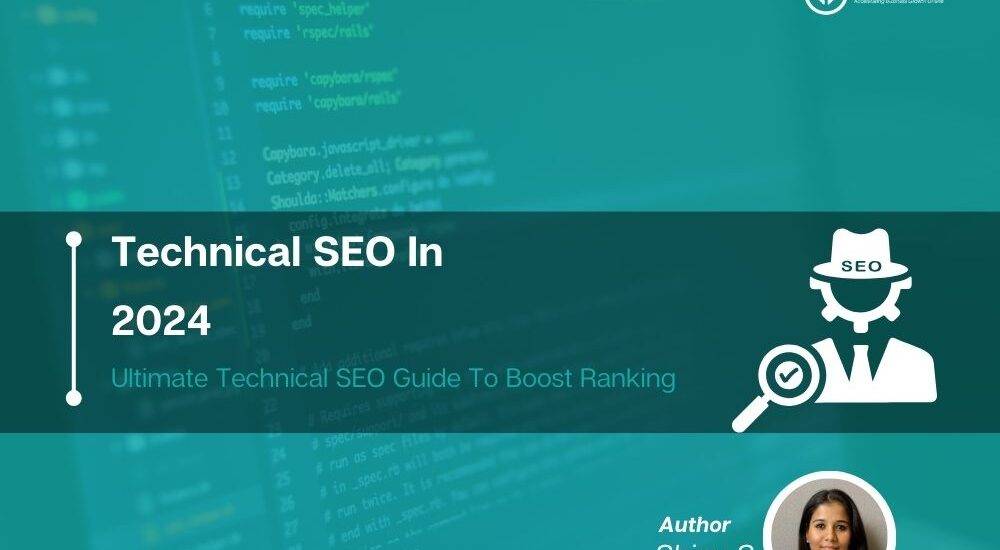Technical SEO In 2024
Ultimate Technical SEO Guide To Boost Ranking

In this Technology Era where fresh technologies come into practice, Marketing Digitally is the new fashion for developed or developing businesses to stay ahead of the Competition. Here comes mastering the Art of SEO. While content creation and link building often steal the spotlight, another crucial aspect that lays the foundation for success is Technical SEO.
What is Technical SEO?
Technical SEO refers to optimizing a website’s framework and backend elements to improve its search engine visibility and rankings. Classic SEO focuses on content optimization and link building, and technical SEO involves improving various technical aspects of a website to make it more crawlable, indexable, and user-friendly for search engines.
In this 2024 guide, Let’s look into the basic concepts of technical SEO, exploring essential practices and strategies to optimize a website’s performance. From site speed optimization and mobile responsiveness to URL structures and schema markup, let us uncover the crucial components that can elevate a site’s visibility in search engine results pages (SERPs) and drive sustainable growth for your business.
Below are Some Basic aspects of Technical SEO
Website Speed
Website speed is crucial in technical SEO (Search Engine Optimization). Here’s why:
- Website speed can directly impact user experience. Google aims to give users the best experience so they can classify fastloading websites in their search results.
- Google prefers mobile-friendly websites. Mobile users often have slower internet connections than desktop users, so having a fast-loading mobile website is crucial for SEO.
- Google allocates limited resources, known as a crawl budget, to websites. Google’s crawlers can crawl more pages within the allocated budget on fast-loading websites, leading to better indexing and higher rankings.
- Google has introduced Core Web Vitals as metrics that measure user experience on the web. These include metrics like Largest Contentful Paint (LCP), First Input Delay (FID), and Cumulative Layout Shift (CLS). Website speed directly impacts these metrics.
- A faster website can give you an edge over competitors. Users like to engage and return to websites that load quickly and provide a smooth browsing experience.
To improve website speed for better technical SEO:
- Optimize Images
- Minimize CSS, HTML, and JavaScript
- Enable Browser Caching
- Use Content Delivery Networks (CDNs)
- Reduce Server Response Time
- Implement Lazy Loading
By preferring website speed optimization as part of technical SEO efforts, One can improve user experience, increase search engine visibility, and ultimately drive more traffic to the website.
Mobile Optimization
Mobile optimization is a required aspect of technical SEO. Due to increasing mobile device usage. Here’s why mobile optimization matters and some strategies to improve it:
- Google mainly uses the mobile version of a website’s content for indexing and ranking.
- Your website won’t perform well in search results if optimization for mobile devices or desktop users is lacking.
- Mobile users expect a seamless and intuitive experience when browsing websites.
- Poorly optimized websites with slow loading times, unresponsive design, or awkward navigation frustrate users and increase bounce rates, negatively impacting SEO.
- Mobile users often have slower internet connections compared to desktop users. Optimizing for mobile involves improving page load times, such as faster loading of pages.
- Website responsive design ensures SEO content renders on various devices and screen sizes.
- Text should be readable without zooming, buttons should be easy to tap, and images should resize appropriately.
- Implement structured data markup like Schema.org to nourish search engines with additional context about your content that enhances visibility in mobile search results, including rich snippets and knowledge panels.
- Tailor content for mobile users by making paragraphs short, using concise headings, and preferring important information at the top of the page.
- Avoid using Flash or other technologies on all mobile devices.
- Confirm that mobile pages have properly optimized titles, meta descriptions, and URLs. These are crucial for both user engagement and search engine visibility.
- Regularly test the website’s mobile-friendliness using tools like Google’s Mobile-Friendly Test. These help identify issues and opportunities for improvement.
- Implementing Accelerated Mobile Pages can improve page load times on mobile devices.
- For businesses targeting local customers, optimization for mobile includes providing accurate and consistent information across directories and using features like Google My Business for better visibility in local mobile searches.
By prioritizing mobile optimization in technical SEO, one can enhance user experience, improve search engine rankings, and drive more organic traffic to the website.
Site Structure and Navigation
Site structure and navigation are crucial elements of technical SEO as they affect how search engines crawl, index, and understand the website’s content. Here’s why site structure and navigation are foremost and some strategies to optimize them:
Crawlability: A clear and logical site structure helps search engine bots crawl and index efficiently. A well-structured search engine in a Site can effortlessly discover and access the pages, improving the website’s visibility in search results.
Indexability: A well-organized site structure guarantees main pages for indexing. By establishing an order of pages and linking them properly, one can ensure that search engines understand the applicability and importance of each page on your site.
User Experience (UX): A logical site structure and intuitive navigation improve the user experience by making it easy for visitors to find the information. When users can navigate your site, they’re more likely to stay longer, engage with your content, and return in the future.
Internal Linking: Proper site structure enables effective internal linking. Link equity (PageRank) throughout the site helps search engines understand the relationships between pages. Internal links guide users to related content, improving engagement and reducing bounce rates.
Keyword Targeting: Organizing the site around targeted keywords or topics improves the chances of ranking terms in search results. By aligning the site structure with a keyword strategy, one can create topical bearing and signal the search engines with the primary focus of the content.
XML Sitemap: A well-structured XML sitemap gives search engines a roadmap of your site’s pages, helping them crawl and index your content more efficiently. Ensure your XML sitemap is up-to-date, includes all pages, and attaches to best practices.
Breadcrumb Navigation: Breadcrumb navigation displays the ranking structure of the site by helping users understand their current location within it by improving User Experience and providing additional context to search engines about the relationship between pages.
Avoid Orphan Pages: Orphan pages are pages on the site that never link to other pages. Ensure that all pages are accessible through the site’s navigation or links from other appropriate pages to prevent them from being overlooked by search engines.
By optimizing site structure and navigation for both search engines and users, one can improve crawlability, indexability, and user experience, ultimately leading to better SEO performance and higher rankings in search results.
Core Web Vitals
Core Web Vitals are specific factors that Google considers necessary in determining the user experience of a web page. They measure aspects of web performance, including loading time, interactivity, and visual stability. Google has displayed that Core Web Vitals will become official ranking factors, highlighting the importance of technical SEO. The three Core Web Vitals metrics are:
Largest Contentful Paint (LCP): LCP measures the loading performance of a web page. It calculates the time for the high-content element, like an image or text block, to become visible to the user. LCP should occur within 2.5 seconds of first loading to provide a good user experience.
First Input Delay (FID): FID estimates the inside activity of a web page. It quantifies when a user first interacts with a page (e.g., by clicking a link or tapping a button) to when the browser responds to that interaction. A good user experience typically has an FID of less than 100 milliseconds.
Cumulative Layout Shift (CLS): CLS counts the visual stability of a web page. It quantifies the unexpected layout shifts that occur during the page-loading process. A layout shift happens when visible elements on the page move unexpectedly, causing users to click on the wrong thing. Pages should maintain a Cumulative Layout Shift of less than 0.1 for a good user experience.
Optimizing Core Web Vitals involves several technical and design considerations:
- Optimize Loading Performance
- Prioritize Critical Rendering Path
- Minimize JavaScript Execution Time
- Avoid Layout Shifts
- Regular Monitoring and Optimization
Optimizing for Core Web Vitals improves the user experience and contributes to better search engine rankings, making it an essential aspect of technical SEO.
Structured Data Markup
Structured data markup, also known as schema markup, has a crucial role in technical SEO by providing search engines with additional context about the content on a webpage. This markup helps search engines understand the meaning of the content, which can lead to wealthier and more informative search results, improving visibility and click-through rates. Here’s how structured data markup contributes to technical SEO:
Enhanced Search Results: Structured data markup can provide search engines with detailed information about the content, like product details, reviews, ratings, prices, event dates, and more that results in enhanced search results, including rich snippets, knowledge graph panels, and other search result feature that makes listings more attractive to users.
Improved Click-Through Rates (CTR): Rich snippets and enhanced search results stand out in search engine results pages (SERPs), leading to higher visibility and click-through rates. Star ratings or product availability directly in the search results may be more inclined to click on the listing.
Better Understanding of Content: Structured data markup helps search engines understand the context and meaning of the content better, which is beneficial for content that includes complex data or specialized information, like recipes, events, job postings, and FAQs. With structured data, it’s easier for search engines to index and rank the content appropriately.
Support for Voice Search and Rich Answers: With the rise of voice search and the increasing importance of featured snippets and good answers, structured data markup has become even more valuable. The content with schema.org vocabulary increases the chances of the content being selected as a featured snippet or used to answer voice search queries directly.
E-commerce SEO: For e-commerce websites, structured data markup can be powerful. By marking up product pages with schema.org vocabulary related to products, offers, reviews, and more, one can provide search engines with detailed information visibility in product search results and drive more qualified traffic to your site.
In summary, structured data markup is an essential component of technical SEO that enables search engines to provide additional context about the content while improving visibility, click-through rates, and overall search performance.
HTTPS and Security
HTTPS (Hypertext Transfer Protocol Secure) plays an integral role in technical SEO, mainly because it enhances website security and user trust. Here’s how HTTPS impacts SEO and contributes to overall website security:
Security and Data Integrity: HTTPS encrypts the data transfer between a user’s browser and the website’s server, providing sensitive information like login credentials, payment details, and personal data remains confidential. These help prevent data breaches, man-in-the-middle attacks, and other security threats, that is essential for maintaining user trust and protecting the website’s reputation.
Ranking Boost: Google has confirmed that HTTPS is a ranking signal, a lightweight one compared to other factors like high-quality content and relevant backlinks. While the impact of HTTPS on rankings may not be significant on its own, Google considers this as a positive signal for website security, and user experience migrating the website to HTTPS can result in a slight boost in search engine rankings.
Browser Warnings: Modern web browsers, including Google Chrome, Mozilla Firefox, and others, display warnings to users when they visit non-HTTPS websites, indicating that the connection is not secure. These prevent users from accessing the website, leading to higher bounce rates and potentially lower search engine rankings. By migrating to HTTPS, you can avoid these warnings and provide visitors with a more secure browsing experience.
Referrer Data: When traffic passes from an HTTPS website to a non-HTTPS website, the referrer data (i.e., the URL of the page the user was on before clicking a link) is in the HTTP header due to security restrictions, means that websites using HTTPS may lose referral data from non-HTTPS sources, impacting their ability to track the source of traffic accurately.
Trust and Credibility: In addition to its technical benefits, HTTPS contributes to user trust and credibility. Websites with HTTPS are more trustworthy and secure by visitors, leading to higher levels of engagement, longer time spent on site, and increased conversion rates.
Technical Error Fixing
Technical error fixing in technical SEO involves identifying and resolving website issues that affect its search engine visibility, indexing, and performance. Here’s a structured approach to address technical errors:
- Utilizing tools like Google Search Console, Bing Webmaster Tools, and third-party crawlers (e.g., Screaming Frog, SEMrush) can identify crawl errors such as 404 pages, server errors (5xx), and redirect chains.
- Paying attention to crawl stats can ensure search engine bots that access the site effectively.
- A clean URL structure that is logical, descriptive, and optimized for keywords is applicable.
- Implement canonical tags to consolidate duplicate or similar content variations to prevent issues with duplicate content.
- Optimize page load times by compressing images, minifying CSS/JavaScript files, leveraging browser caching, and utilizing a content delivery network (CDN).
- Implement a responsive design that adapts to all screen sizes and devices.
- Testing mobile usability using tools like Google’s Mobile-Friendly Test can address the identified issues.
- Ensure the website is served over HTTPS to encrypt data transmission and security.
- Implement schema.org markup for search engines with additional context about the content to improve the chances of rich snippets and search results.
- Create and submit an XML sitemap to search engines that help them discover and index the website’s pages.
- Ensure robots.txt to guide search engine crawlers and exclude sensitive or irrelevant pages from indexing.
- Fixing broken internal links and making sure anchor text is descriptive and optimized for relevant keywords.
- Regular testing and validity of structured data markup using tools like Google’s Structured Data Testing Tool can ensure accuracy and compliance with schema.org standards.
- Regularly monitor the website’s performance, crawl errors, and indexing status using different tools and analytics platforms.
- Stay informed about algorithm updates and industry best practices to stay ahead.
By addressing technical errors and continuously monitoring website performance, one can ensure that the website remains optimized for search engines and provides a positive user experience, ultimately improving its visibility and rankings in search results.
Conclusion:
In conclusion, mastering technical SEO is crucial for any website aiming to succeed in the competitive digital world. While content quality and link building are crucial components of SEO, the technical aspects can inhibit a site’s ability to rank well in search engine results and attract organic traffic.
By optimizing elements like site speed, mobile responsiveness, URL structure, and schema markup, businesses can improve their website’s crawlability, indexability, and user experience. This technical improvement not only pleases search engine algorithms but also enhances the overall usability and accessibility of the site for visitors.
Investing time and resources into technical SEO not only boosts search engine rankings but also lays a solid foundation for long-term success online.
As search engine algorithms continue to evolve and user expectations too, staying up-to-date with technical SEO best practices is crucial for maintaining and improving a website’s performance.






